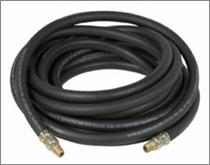
Steam hoses play a critical role in various industries in transmitting hot water or steam from one point to another. They can carry pressurised hot water in many cleaning applications, blowout service, thawing, and fire prevention. Since they perform such a critical role, it is essential to handle their installation, maintenance, and usage properly. So, let us share some best practices that can help you get the maximum life out of steam hoses. This post covers some essential maintenance tips and precautions to be taken when handling steam hoses.
Tagging or Marking
Steam hoses mostly last about 3-35 years before they need to be replaced. So make sure you know when they go into service. Once you buy a steam hose, tag it with important information like specifications to help the operator locate the requisite documentation whenever needed. You may ask your supplier to etch the coupling of each hose with a serial number, as it can help with tracking and record keeping.
Crimped-On Hose Couplings
If the coupling blows off the hose under pressure, it can increase the potential for serious injury. Hence, you must pay attention when choosing the coupling. Crimping is the most preferred method for steam hose assemblies. Crimped coupling is a permanent attachment that reduces the potential for leaks and blowouts. It also eliminates the need to retighten the clamps as it forms a tight crimp that reduces leaks and eliminates bulky bolt clamps. This reduces the potential for damage due to snagging.
Colour Coding
It is suggested that you use a different colour hose for each application. You can create a good colour-coding system to add an extra layer of safety and protection to the operations.
Safety Cables
Since steam hose failures can cause catastrophic consequences, it is important to install OSHA-approved safety cables at every junction. This will prevent the hose from whipping around if the couplings disconnect.
Maintenance and Storage
Ensure that maintenance is done regularly by a qualified inspector, as it will help maximise the life of the steam hose. Inspect each hose before and after use. If it shows signs of possible damage, replace it immediately to avoid hose failure. These signs of damage may include kinks or flattening, blisters and other abnormalities, loose fittings, areas of gardening or inflexibility, and actual steam leakage.
You may request the supplier to come in and inspect the steam hose. If you want to do any additional pressure testing, it can be done safely in a contained test tank. The hoses should be stored at normal temperatures and drained after each use. If storing on a hose rack, ensure that you avoid any kinks or bends in the hose, as they can damage the steel reinforcement.
Select a Good Hose Fabricator
When selecting a hose fabricator, make sure it meets all quality standards, safety guidelines, and qualifications. The equipment it uses should be carefully assembled and tested.
Summing Up
So, make sure you follow these best practices, safety precautions and guidelines, not only to enhance the life of the steam hoses but also to ensure the safety and protection of your workplace and workers.
Featured Image Source: https://www.jreltd.com/images/utility-hoses/pic7.jpg


Leave a Reply